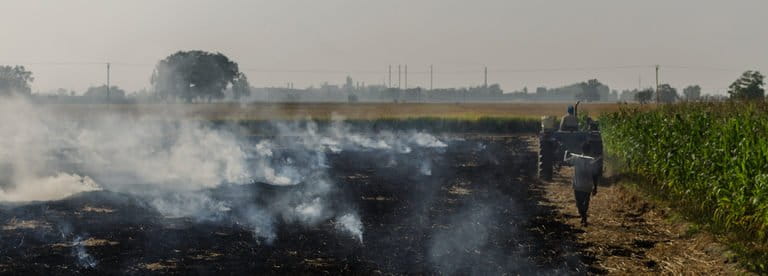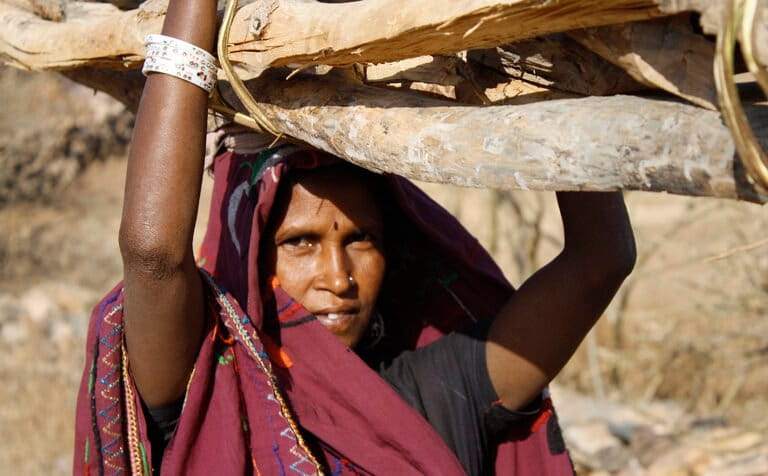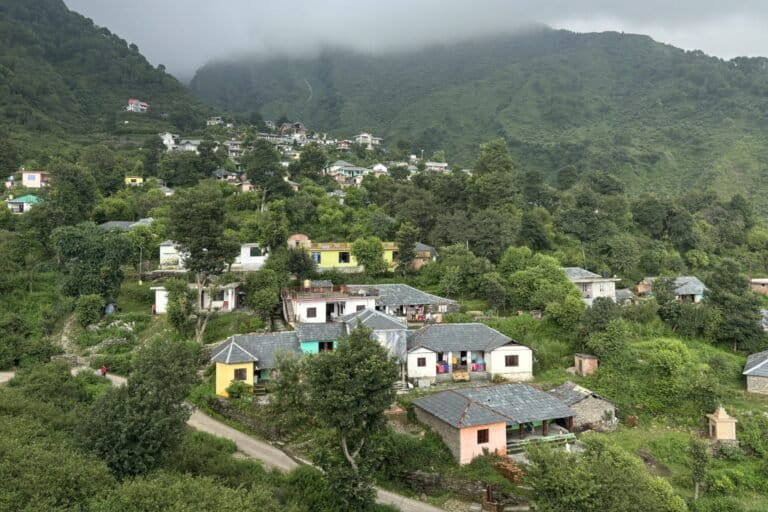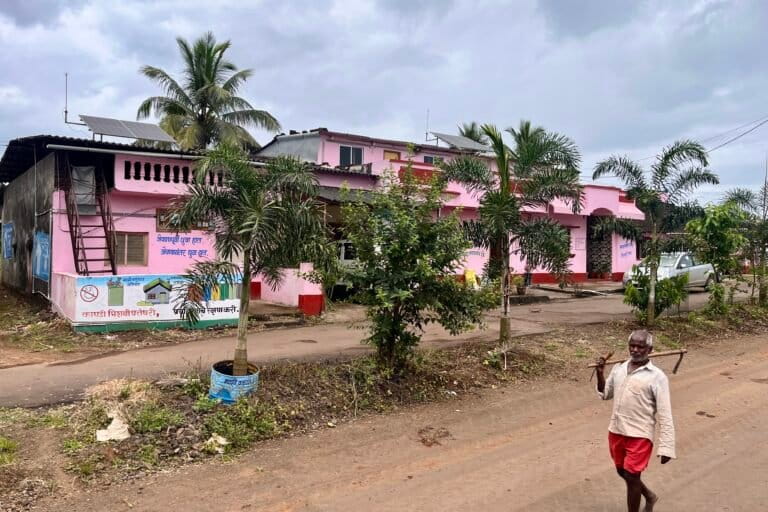- Paddy stubble burning in Punjab is often blamed for air pollution in north India. The government has been introducing alternatives over the years but these are yet to make a substantial impact on the ground.
- High operational cost of machines weighs heavy on the already indebted farmers. Additionally, lack of training in machine-use results in higher input cost and lower production.
- Local solutions and traditional collaborations with herders are some of the low-cost ways that need to be promoted which may help farmers move away from the practice of straw burning.
Last month, on December 11, farmers in Punjab held three officials of the state agriculture department hostage at Kabar Bachha village in Ferozepur district. They alleged that an insect, the pink stem borer, had infested their wheat crop after they followed the advice of the officials to not burn paddy straw, a common post-harvest practice in Punjab and neighbouring states.
“We had to bear a loss of 4 quintal per acre in yield besides extra cost of Rs. 500-1,000 per acre for the pesticides that had to be used,” said Gurwinder Singh Dhaliwal, a farmer from Rameanah village in Faridkot district who cultivated wheat without burning paddy straw last year.
Punjab, along with Haryana and Uttar Pradesh, garners attention during the paddy harvesting season every year, starting in October. Farmers put their fields on fire to quickly clear off the straw left behind after paddy harvesting and before cultivating wheat. The short window between harvesting of paddy and sowing of wheat along with the high cost of manual or mechanical management of straw, forces farmers to set fire to their fields. This year, the window shrank further due to late rains and floods that delayed paddy harvesting.
The burning is often blamed for the severe air pollution in Delhi during this season. The share of farm fires to the capital’s pollution, however, depends on daily instances of fires and the weather conditions. This year, the contribution of farm fires to Delhi’s air pollution varied from 2 to 46 percent, showed data from the System of Air Quality and Weather Forecasting And Research (SAFAR-India) of Indian Institute of Tropical Meteorology, Pune.
Inderjeet Singh, chief agricultural officer in Pathankot district, feels insects like pink stem borer, that infected the farmers’ wheat crop, are going to be a bigger problem in next few years. “Farm fires used to get rid of such insects. We are now witnessing a rise in their population due to favourable environment (for the insects),” he said. “Unless scientists come up with a good solution to this problem, all the efforts made to reduce burning till now will be undone.”
Punjab registered more than 50,000 farm fires this year, causing health ailments from air pollution and road mishaps due to poor visibility. After the Supreme Court took suo moto notice of the pollution emergency, the state administration got active. It registered FIRs, issued challans and arrested farmers engaged in straw burning. Now the government is trying to mollify angry farm unions protesting for withdrawal of FIRs, removal of red entries in farmers’ revenue records and waiver of fines.

The government has offered several solutions and schemes over the years but these are yet to make a substantial impact on the ground. Before the paddy harvesting season of 2019 began, farmers had flagged problems with the proposed solutions. On September 25, 2019, a social media post by Punjab Chief Minister Capt Amarinder Singh claimed that the state’s agriculture department had initiated a drive to provide more than 26,000 machines to farmers, with a subsidy of Rs. 278 crore to ensure paddy straw management in the coming months. The post garnered instant likes from supporters and angry comments from others claiming corruption in subsidy component besides inefficiency and high cost of operating these machines.
The Chief Minister also asked Centre to give Rs 100 per quintal incentive to paddy growers, a demand that the state government later reiterated at a hearing by the National Green Tribunal.
The demand was rejected but the Supreme Court took up the issue later and the state government announced Rs 2,500 per acre incentive to small and marginal farmers on November 13. The announcement was, however, too late because the season was almost over.
Land of machines
Farming in Punjab is highly mechanised which has helped deal with labour shortage but led to high debts and bigger ecological disasters. There is one tractor available for every 8.7 hectares of cultivable land in Punjab and average use of tractors is less than 40 percent of the 1,000 hours required for economic viability, said the draft Punjab State Farmer’s Policy .
A study done by Punjab Agricultural University and published in 2014 found that loans taken for farm inputs and machinery formed 52 percent of the total debt incurred by farmers. For small farmers the share went up to 68 percent which reduced their borrowing capacity for other purposes like healthcare and social ceremonies.
Promotion of machines, which remain in use only for straw management, has further compounded the crisis. Though there is an attempt to make these machines available on rent, it remains inadequate.
This year the state government made super straw management system (Super-SMS) compulsory for combine harvesters. Combine harvester is a machine used by farmers which harvests paddy and separates the grains from straw. The Super-SMS is an attachment on the combine harvester which further chops the straw and spreads it in the field as mulch. The government announced that any combine harvester without a Super-SMS will be confiscated. The first case was reported from Bughipura village of Moga district on October 15. A press note was sent out with photograph of cops and officials posing in front of the confiscated machine. It said that the farmer, Prem Singh, was found harvesting paddy without using the super SMS that was installed on the combine harvester.
However, on investigation it was found that Prem Singh is neither a farmer nor owns any piece of farm land. A visit to his house revealed that he is a mechanic who owns a combine harvester and rents it out during the harvesting season. The administration did not confiscate the machine because the order for seizure was only for those combine harvesters that did not have Super SMS. “We have the Super SMS but when used, the harvesting cost increases by 50-60 percent because of higher fuel usage, reduction in speed of harvesting besides maintenance cost. Farmers are not willing to pay extra,” Prem Singh said. “I told the officials, we get money from farmers, not from you. We will follow their command.” Farmers are also wary of Super SMS because there are chances of grains getting into the machine leading to loss of produce.
Besides the cost of operation, many owners of combine harvesters can’t install Super SMS. Industry estimates suggest that around 35 percent harvesters in Punjab are mounted on tractors below 65 horsepower capacity, which can’t bear the extra load of Super SMS. This effectively means farmers have to overhaul the whole set up. Still, police confiscated combine harvesters across the state after the Punjab Pollution Control Board (PPCB) issued challans and imposed a fine of Rs 2 lakh on each machine for violation of pollution norms. Farmers are now protesting for release of their harvesters.
“The government has been imposing costly machines rather than asking us what will work. It needs to provide financial support instead of issuing challans and filing FIRs,” said Harjeet Singh, a farmer at Jogewala village in Moga district. “Why would those willing to commit suicide due to debt, fear challans?”
The state government offers varying subsidies, 50 percent to individual farmers, and 80 percent to groups of farmers and cooperative societies. But the machines remain expensive. “The NGT order of December 10, 2015, had said that machines should be provided for free to farmers with less than two acres of land. No such support has been provided,” said Ajmer Singh Rajewal, president, Bharti Kisan Union (Rajewal), one of the prominent farmers’ groups in Punjab. “Subsidies have not helped farmers because the rates of machines went up after the subsidy was announced. What else can we call it but the nexus between government and corporate.”
The officials, however, deny the allegations. “Similar machines but with lower quality parameters and specifications might be available in the market at less rates,” said K S Pannu, Secretary (Agriculture) in Punjab government. “Machine manufacturers have been empaneled at the level of Central government and the specifications and rates were also frozen at the national level,”
Industry leaders also echo same thoughts. “There are many local manufacturers who are offering same machines at less rates but the standard specifications are lower resulting in poor performance,” said Sarabjeet Singh, Managing Director of Dashmesh Mechanical Works, one of the government empaneled manufacturers.
“As a rule, cost of technology and machines decline with time but in case of farm machines under subsidy, the rates have increased,” said agri entrepreneur Vikram Ahuja. “The government should convey the reasons for the same to the farmers.”
The state government claims to make the farm machines available on rent to small and marginal farmers through machine banks of cooperative societies. The banks are, however, are still ill equipped to deal with the huge demand or just exist on paper. A team from the Central Farm Machinery Training & Testing Institute Budni, Madhya Pradesh, could not find 34 of 107 such banks listed in government records. Many of the machines at these centres were also found to be under utilised or missing and the staff untrained. Even though the state government claimed that there were some discrepancies in the list with the Central team, non-availability of machines is a fact.
Punjab could meet only 39 percent of the target regarding delivery of farm machines to custom hiring centres, showed data submitted to the National Green Tribunal. The data regarding individual farmers was even more dismal as only 21 percent of the target delivery of machines to farmers was met.
Not so happy seeder
The government, as well as non-government organisations, have been promoting Happy Seeder, a machine for zero-till sowing of wheat, which avoids burning of paddy.

Farmers, however, often complain that use of Happy Seeder leads to decline in the wheat crop due to infestation of insects and diseases besides high soil moisture that is not beneficial to the crop. Gurpreet Singh Dabrikhana, a social activist who has been promoting natural farming in Punjab, believes Happy Seeder shows results only on light soils. “In heavy soils, the problem of insects is prevalent which affects the yield and increases cost of cultivation,” he added.
Agri-entrepreneur Vikram Ahuja is a strong advocate of letting the farmers decide what suits them the best. “The results of Happy Seeder varies from farmer to farmer and soil to soil. Dismissing it as an utter failure will be as bad as promoting it as an ultimate solution,” he added. “For generations, farmers have been trained to sow on a clean field. Now we are telling them to unlearn and follow zero tillage.”
Others believe that performance issues with Happy Seeder can be managed by changing traditional practices like timing of irrigation and application of fertilisers and pesticides.
“Till now, the government has focused more on machine distribution and less on capacity building of farmers on how to use these machines for maximum benefit,” said Manoj Singh, head of crop residue management programme at The Nature Conservancy, a Delhi-based non-profit. “Benefits of Happy Seeder get evident in third or fourth year but farmers lose patience after first use which is why their handholding is required. Long term benefits of using this technology include decline in cultivation cost besides improvement in soil health and water conservation.”
Viability of biomass power plants
Sukhchain Singh of Magyar village in Patiala district recently sold one acre of his farm land. He had to repay the loan taken to buy a baler and rake machine combo. The twin machines are used to uproot paddy straw and compress it into bundles for easy transportation.
Singh is one of the around 100 farmers who bought these machines for Rs 20 lakh to supply the straw bundles to a 12-MW biomass-based power plant established by the Punjab Biomass Power Limited near Patiala. The power plant shut operations in 2017 leaving them stranded. “The company is yet to pay around Rs 5 crore of farmers. We bought all these machines hoping the profit from supplying straw to plant will help repay the loan,” Sukhchain Singh said. “Now we take the baler to areas as far as 50 km to remain in profit.”
Punjab currently has nine biomass power plants of 72.5 MW capacity and plans to add four more of 61 MW capacity. It has regularly signed agreements with different companies to set up hundreds of biomass power plants across the state but only a few materialise. One of the primary reasons, industry experts say, is lack of tariff support and competition from solar energy.
“The government should promote biomass the same way it supports wind and solar sectors. The projects need to be scaled up to attract big companies and foreign investors. Currently, we have very small biomass-based power projects most of which run into losses due to low tariff support,” said Lt Col Monish Ahuja (retd), director of Punjab Renewable Energy Systems Pvt. Ltd. (PRESPL). “We need to have a mix of things instead of just power projects, especially since huge amount of paddy straw is generated. Biomass can be used to produce briquets, CNG, ethanol besides other products.”
M P Singh, joint director at Punjab Energy Development Agency (PEDA) denies the claims of commercial non-viability. “The tariff rates are fixed by the regulator and all the companies get 5 per cent increase annually. Except one power project, all other biomass plants are functioning in Punjab,” he said.
Local, decentralised solutions
Air pollution has also pushed farmers to come up with innovations in straw management. Gian Singh of Jairampur village in Kapurthala district experimented with a low-cost technique that involves sprinkling of wheat seeds with urea fertiliser when the paddy straw is still standing in the field. The straw is then cut with a reaper and covers the ground. Urea and water decompose the straw over time while wheat shoots sprout from below. “Earlier I would burn the straw and get wheat yield of 20 quintal per acre. With this technique the yield is 23 quintal and water use has also reduced,” said Gian Singh. “From one acre two years back, I have extended this method to the whole of 30-acre land I cultivate.”

The cost with this technique is Rs 400 per acre as compared to Rs 2,500-4,000 expenditure on hiring labour or seeder machines. “Crop reaper, a common, low-cost machine is the only implement used through this method. Compare this to expensive machines like Happy Seeder which also remain idle after the wheat sowing,” said Gurpreet Dabrikhana who has been promoting the method among other farmers. “Wheat on around 25,000 acre has been planted in Punjab using the method this year.”
Animal herders and farmers have been collaborating for centuries to dispose off surplus crop residue. Paddy straw is high in silica and low on nutritional value which is why many dairy farmers desist from feeding it to milch cattle. Nomadic herder communities, like Gujjars, however, still use the straw as fodder and bedding in animal sheds. Not being able to afford costly feed, they pick up the paddy straw from fields or let their animals graze on farm for free or at a small payment to farmers.
The occupation is, however, on decline and collaboration between farmers and herders is now restricted to very few pockets adjoining the hills. A special arrangement to ease movement of herders during the season can promote this low cost recycling of paddy straw into milk and manure.
Banner image: Paddy stubble burning in a farm in Haryana. Stubble burning in Punjab and Haryana is a major cause of air pollution in north India. However, farmers have little choice as other options to get their fields ready for the next crop, are too heavy financially. Photo by Saagnik Paul/Greenpeace.














